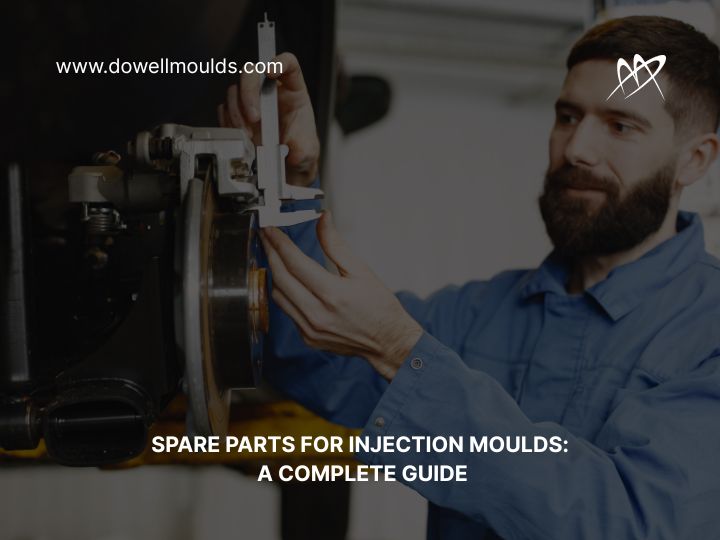Injection moulding is among the most commonly used production methods for plastic components in industries ranging from electronic to automotive packaging and medical equipment. To keep the production lines operating smoothly, keeping up not just the injection moulding equipment but also the moulds is essential.
Parts for spare injection moulds can play an essential role in ensuring that the product is of consistent quality, reducing downtime, and prolonging the useful life of costly tools. This guide will explain the different kinds of spare parts, their uses and replacement requirements, and tips for keeping the injection moulding process running smoothly.
Why Spare Parts Are Crucial in Injection Moulding
Injection moulds undergo constant thermal cycles, extreme pressures and mechanical stress. In time, this continuous wear and tear affects the parts within the mould. This can lead to:
-
Dimensional inaccuracies
-
Flashing or short shots
-
Slower cycle times
-
Unplanned machine downtime
Maintaining vital spare parts that are readily available helps ensure quick replacements, decreases downtime and protects against lengthy production delays that can be costly.
Key Spare Parts for Injection Moulds
Let's take a look at the most essential spare components that you must have on hand and the specific roles they serve:
1. Ejector Pins
-
Funktion: Push the plastic component that has been moulded from the mould cavity when it has cooled.
-
Everyday Wear Issues: Bending, galling, or surface wear.
-
When should you replace: When pieces begin sticking to the cavity or when ejector pin marks appear.
2. Guide Pins and Bushes
-
Function: When closing the mould, ensure an exact alignment between the central and cavity halves.
-
Everyday Wear Issues: Wear or scoring due to repeated friction.
-
The time to replace: If alignment gets sloppy or flashing occurs.
3. Sprue Bushings
-
Function: The nozzle directs hot plastic from the nozzle system into the runners.
-
Common wear issues: Erosion cracking, cracking or the fatigue of thermal energy.
-
The time to replace: If leakage happens or flow irregularities occur.
4. Core and Cavity Inserts
-
Use: Form the moulded shape of the item within the mould.
-
Everyday Wear Issues: Surface wear, erosion, or cracking.
-
What is the best time to replace it? If the dimension of the product is off or surface defects are visible,
5. Lifters and Slides
-
Function: Help to remove the complex shapes of parts from moulds by executing in the opposite direction.
-
Common wear issues: Misalignment and jamming or wear because of poor oil lubrication.
-
What is the time to replace: If the movement becomes rigid or parts cannot be ejected easily.
6. Cooling System Components (Plugs, Connectors, Seals)
-
Funktion: Regulate the mould's temperature while in operation.
-
Everyday Wear Issues: Corrosion, leaks, or clogging.
-
When should you replace: When the efficiency of cooling drops or leaks are discovered.
7. Locating Rings
-
Function: Ensure the mould is aligned to the machine's injector unit.
-
Everyday Wear Issues: Surface wear or distortion.
-
What is the time to replace: If issues with alignment or uniform injection marks show up.
When Should You Replace Mould Spare Parts?
Maintenance prevention is crucial for injection moulding. It is recommended that parts be examined often and repaired when they begin to fail.
Common substitute triggers are:
-
Surface scratches on the finished product
-
Increases the time to cycle
-
Abnormal wear patterns during visual inspection
-
Cooling inefficiencies
-
Ejection problems
Pro Tips: Keep your maintenance log that records the replacement of parts, any issues and the time between service for every mould you have in your shop.
How to Choose Quality Spare Parts
If you are looking for spare parts for injection moulds, think about the following factors:
-
Material Compatible: Use components made of hardened tool steel, nitrided and nitrided steel or stainless steel to provide durability against corrosion, based upon the use.
-
Tolerance and Precision: Ensure that your equipment meets original equipment manufacturer (OEM) tolerances or higher.
-
Surface Finish Surfaces that are polished on ejector pins and in the cavities minimize wear and friction.
-
Compatible with Brands: Some mould components are standard (e.g., DME, HASCO or MISUMI), and others are mould-specific. Find out what your mould needs.
Tips for Use: For vital parts, such as lifting pins, ejectors or ejectors, ensure that you have certified, top-quality spares available for rapid replacement.
Spare Parts Storage and Inventory Tips
A well-planned spare part strategy for managing spare parts can help save Production time
-
Sort by the mould reference number: Label containers for spare parts with the mould's number.
-
Utilize Inventory Software to Keep track of stock levels and automatically reorder low stocks.
-
Maintain a dry, clean Space: Protect from dust and corrosion.
-
Check your spare inventory regularly: Ensure there are no items that have been used over their shelf-life, including connectors, seals, and other components.
Benefits of Proper Spare Parts Management
-
Reduced Downtime Rapid replacement ensures that production can continue without delays.
-
Better Quality of Product: Prevent damage caused by worn components.
-
Extension of Mould Life Replacement of worn parts according to schedule minimizes the cost of mould tooling by reducing damage.
-
Cost Efficacy: Eliminates urgent repairs as well as last-minute rush orders.
Conclusion and Final Thoughts
Making sure you purchase high-quality and properly controlled spare components for your moulds is vital to ensure an efficient, reliable production line. If you understand the role of the key parts, observing wear indicators and keeping an inventory of spare parts will help extend the mould's life span, increase the quality of your product, and avoid expensive interruptions.

